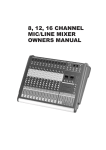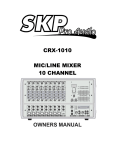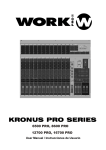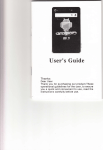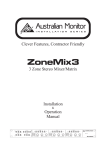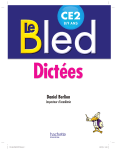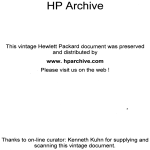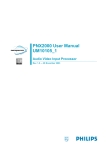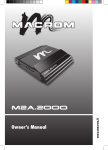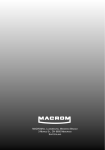Download OWNERS MANUAL
Transcript
OWNERS MANUAL A. IMONO CHANNEL SECTION 2~3 B. STEREO CHANNEL SECTION 4~5 C. MASTER SECTION 6~7 D. MAIN OUTPUT SECTION 8 E. POWER SECTION 9 F. INSTALLATION 9 G. CONNECTIONS 10~11 H. APPENDIX 12 Ultra low noise 10 Channel Mic / Line Mixer 6 Mono Input Channels with sliver plated XLRs and balanced Line Inputs Ultra-low noise discrete Mic Preamps with +48 V Phantom Power 2 Stereo Input Channels with balanced XLRs and TRS Jacks Extremely high headroom - offering more dynamic range Balanced Inputs for highest signal integrity Ultra-musical 3-band EQ on all channels 1 Aux Sends per channel for external effects and monitoring 256 DSP system inside Highly accurate 6 segment Bargraph Meters Separate master mix output SAFETY INSTRUCTIONS CAUTION: To reduce the risk of electrical shock, do not remove the cover (or back). No user serviceable parts inside; refer servicing to qualified personnel. CAUTION RISK OF ELECTRIC SHOCK DO NOT OPEN WARNING: To reduce the risk of fire or electrical shock, do not expose this appliance to rain or moisture. This symbol, wherever it appears, alerts you to the presence of uninsulated dangerous voltage inside the enclosure - voltage that may be sufficient to constitute a risk of shock. This symbol, wherever it appears, alerts you to important operating and maintenance instructions in the accompanying literature. Read the manual. 1 A. MONO CHANNEL SECTION 1. BALANCE INPUT (MIC) Electronially Balanced inputs acceptable a standard XLR male connector. + 48V Phantom Power available on each input Mic socket. and this switch is on Rear Phantom Power. 2. LINE INPUT The unbalanced Mic input is provided for the use of an unbalance mic and is designed to accept an unbalanced high impedance input signal. (This use for connection Deck, Turntable, Keyboard etc..) 3. PAD When pushing this switch, attenuates the input signal -20dB. 4. LOW EQ This control gives you up to 15 dB boost or cut at 80Hz and below. This circuit is flat (no boost or cut) at the center detent position. This frequency reptesents the punch in bass drums, bass guitar, fat synth patches, and some really serious male singers. 5. MID EQ Short for “midrange”, this knob provides 12 dB of boost or cut, centered at 2.5KHz, also flat at the center detent. Midrange EQ is often thought of as the most dynamic, because the frequencies that define any particular sound are almost always found in this range. You can create many interesting and useful EQ changes by turning this knob down as well as up. 5 4 3 2 1 2 6. HI EQ This control gives you up to 15 dB of boost or cut at 12KHz and above, and it is also flat at the detent. Use it to add sizzle to cymbals, and an overall sense of transparency or edge to keyboards, vocals, guitar, and bacon frying. Turn it down a little to reduce sibilance, or to hide tape hiss. 10 9 7. EFF This is normally derived after the EQ and channel fader (POST FADER, POST EQ), and is therefore follow any changers in fader level. They are normally used to drive effects processing units which are fed back into the mixer and which must fade out with the input channel. 8 7 8. MONITOR This has a function which controls the volume on only channel want to monitor with monitor amplifier and sends the signal by Monitor output. (Unless you will use monitor on any channel turn to “O” Position of MON control at that channel.) 6 9. PAN The pan control sends continuously variable amounts of the post fader signal to either the left or righ main busses. In the center position equal amounts of signal are sent to the left and right busses. 10. CHANNEL FADER This is function to adjust the volume of signal connection into each channel and adjust the volume of output, together with master fader. Normal operating position is at the “O” mark, providing 4dB of gain adove that point, if required. 3 B. STEREO CHANNEL SECTION 11. BALANCE INPUT (MIC) Electronially Balanced inputs acceptable a standard XLR male connector. + 48V Phantom Power available on each input Mic socket. and this switch is on Rear Phantom Power. 12. LEFT (MONO) / RIGHT Line with connection 1/4 jack as line input of L, R stereo and input the signal of balance line level. If the signal input into the input terminal of left side, output the mono output to left & right side. If the signal input the input terminal of right side, output into the right side only. If each signal input the input terminal of left & right, output a stereo of left & right. 15 13. LOW EQ This control gives you up to 15 dB boost or cut at 80Hz and below. This circuit is flat (no boost or cut) at the center detent position. This frequency reptesents the punch in bass drums, bass guitar, fat synth patches, and some really serious male singers. 14 13 14. MID EQ Short for “midrange”, this knob provides 12 dB of boost or cut, centered at 2.5KHz, also flat at the center detent. Midrange EQ is often thought of as the most dynamic, because the frequencies that define any particular sound are almost always found in this range. You can create many interesting and useful EQ changes by turning this knob down as well as up. 15. HI EQ This control gives you up to 15 dB of boost or cut at 12KHz and above, and it is also flat at the detent. Use it to add sizzle to cymbals, and an overall sense of transparency or edge to key-boards, vocals, guitar, and bacon frying. Turn it down a little to reduce sibilance, or to hide tape hiss. 4 12 11 16. EFF This is normally derived after the EQ and channel fader (POST FADER, POST EQ), and is therefore follow any changers in fader level. They are normally used to drive effects processing units which are fed back into the mixer and which must fade out with the input channel. 19 18 17. MONITOR This has a function which controls the volume on only channel want to monitor with monitor amplifier and sends the signal by Monitor output. (Unless you will use monitor on any channel turn to “O” Position of MON control at that channel.) 17 16 18. PAN The pan control sends continuously variable amounts of the post fader signal to either the left or right main busses. In the center position equal amounts of signal are sent to the left and right busses. 19. STEREO CHANNEL FADER This is a function to adjust the volume of signal connection into each channel and adjust the volume of output, together with master fader. Normal operating position is at the “0” mark, providing 4dB of gain adove that point, if required. 5 20 26 22 23 21 24 25 C. MASTER SECTION 20. EFFECT PROGRAMS INDICATE 256 Digital Multi Effects. 21. MUTE Effect ON/OFF. 22. UP TAPE SWITCH One push, one program up push with more than 5 seconds hi-speed program up. 23. DOWN TAPE SWITCH One push, one program down, push with more than 5 seconds, hi-speed program down. 24. Pre-set Push more than 5 seconds, It automatacally memorize the displayed program number. Once Just Push M1. M2. M3. M4, always display memorized program. 25. EFFECT LEVEL Using by this control, you can adjust signal level of echo repeat & exteral effect. 26. ON The POWER LED will be turned on when start working. 6 28 27 29 30 31 32 33 34 27. POWER SWITCH Push marked (I), when you want to operate. The LED (26) will be turned on when working. 28. STEREO GRAPHIC EQUALIZER 2X7-band equalizer is provided for tone control over each frequency, and for precise high quality sound by final tone control. 29. OUTPUTS LEVEL INDICATOR This is level meter which shows output levels of left & right channel condition on the way of operation, therefore, you can see output condition thru this master level indication. 30. EFFECT RETURN This is used for adjusting frequency of echo repeat, since too echo repeat may cause a nowl, please adjust frequency properly. 31. AUX IN You can adjust the volume of AUX IN signal by this when connecting AUX IN. 32. TAPE IN You can adjust the volume of TAPE in signal by this when connecting tape in. 33. MASTER FADER (LEFT / RIGHT) This is a master fader for adjustment for volume of LEFT/RIGHT output. Unity gain is the top their travel. 34. MONITOR This has a function which controls the volume on only channel want to monitor with monitor amplifier and sends the signal by Monitor output. (Unless you will use monitor on any channel turn to “O” Position of MON control at that channel.) 7 D. MAIN OUTPUT SECTION 35 36 37 38 39 40 41 42 35. PHANTOM POWER SWITCH Depressing this switch applies 48V DC across all microphone input channels connectors for remote powering of condenser microphones. 36. FOOT SWITCH This jack used for converting between foot switch and DSP. 37. AUX RETURNS & SENDS This can be used to connect all kinds of effects from outside. 38. AUX IN This jack is to be connected with various external auxiliary signal. 39. TAPE INPUT JACK This jack is to be connected with cassette deck when playing back. 40. RECORD PIN JACK This jack is to be connected with cassette deck when recording the mixed output. 41. MAIN OUTPUT In this product, the final confirmed sound can be send to main amplifier through XLR & 1/4 jack. 42. MONITOR OUTPUT This jack to be connected with the input jack of monitor amplifier when using separate monitor amplifier. 8 E. POWER SECTION 45 44 43 43. SPEAKER JACK (LEFT / RIGHT) 44. AC POWER CORD/FUSE 45. FAN In order top prevent rising the inside temperature, the inside heat is emitted outside. F. INSTALLATION Experience tells us that the cables in a studio environment get tangled very quickly (inviting mistakes). +6 SURROUND +3 +1 MODEL-DVP-3000 AMPLIFIER DIGITAL 0 -1 -3 L -6 dB R 01 09 17 25 02 10 18 26 03 11 19 27 04 12 20 28 05 13 21 29 06 14 22 30 07 15 23 31 08 16 24 32 POWER TAPE OUTPUT L&R INPUT L&R 9 G. CONNECTIONS You will need a lot of cables for different purposes - see the following figures to make sure you have got the right ones. Unbalanced equipment may be connected to balanced inputs/outputs. Either use mono 1/4" jacks or connect ring and sleeve of TRS jacks. Headphones Tip = Left signal Ring = Right signal Sleeve = Ground / Shield Tip Ring Sleeve Strain relief clamp Headphone connection Output Cable Input Ground Pin 1 2 1 Pin 2 = (+) Signal 3 Shield (+) Signal + Hum (-) Signal + Hum Pin 3 = (-) Signal 1 2 Positive (+)Hum + Signal Negative (-)Hum + Signal 3 2 x Signal RFI and Hum Compensation of interference with balanced connections 10 = Signal + 6 dB Unbalanced use of mono 1/4" jack plugs Balanced use of stereo 1/4" jack plugs Tip = Signal Tip = hot (+ve) Ring = cold (-ve) Sleeve = Ground / Shield Sleeve = Ground / Shield Tip Tip Sleeve Ring Sleeve Strain relief clamp Strain relief clamp For connection of balanced and unbalanced plugs, ring and sleeve have to be bridged at the stereo plug. Balanced use with XLR connectors 2 1 3 1 = Ground / Shield 2 = hot (+ve) 3 = cold (-ve) 1 Input 2 3 Output For unbalanced use pin 1 and pin 3 have to be bridged Different plug types 11 H. APPENDIX Specifications Mono Inputs Mic Input Bandwidth Distortion (THD & N) Mic E.I.N (22 Hz - 22 kHz) TRIM range electronically balanced, discrete input configuration 10 Hz to 60 kHz ± 3 dB 0.01% at +4 dBu, 1 kHz, Bandwidth 80 kHz -129.5 dBu, 150 Ohm source -117.3 dBqp, 150 Ohm source -132.0 dBu, input shorted -122.0 dBqp, input shorted +10dB to +60dB Line Input Bandwidth Distortion (THD&N) Line level range electronically balanced 10 Hz to 60 kHz ± 3 dB 0.01% at +4 dBu, 1 kHz, Bandwidth 80 kHz +10 dBu to -40 dBu Equalization Hi Shelving Mid Range Lo Shelving 12 kHz +/-15 dB 2.5 kHz +/-15 dB 80 Hz +/-15 dB Steroe inputs Line Input Bandwidth Distortion (THD & N) unbalanced 10 Hz to 55 kHz ±3 dB 0.01% at +4 dBu, 1 kHz, bandwidth 80 kHz Equalization Hi Shelving Mid bell Lo Shelving Lo Cut (High Pass) filter 12 kHz +/-15 dB 100Hz -8KHz +/- 15dB, Q fixed at 1 oct 80 Hz +/-15 dB, Q fixed 2 oct -3dB at 75Hz, 18dB / oct Master Mix section Max Output Aux Send Max Out Control Room Out Signal-To-Noise Ratio +22 dBu balanced +22 dBu unbalanced +22 dBu unbalanced 112 dB, all channels at Unity Gain Power supply Mains Voltages 12 USA/Canada U.K./Australia China 120V 60Hz 240V 50Hz 220V 50Hz














